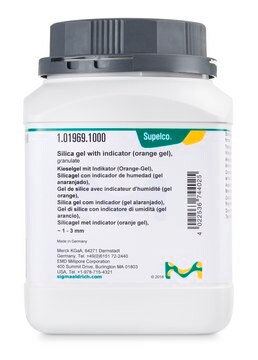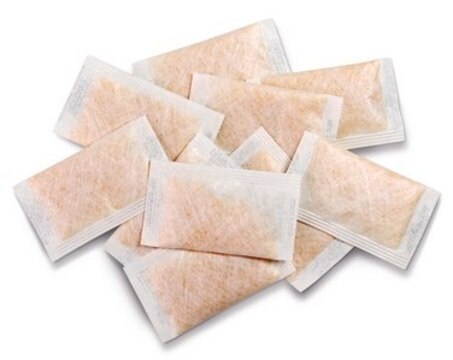94098
Drying pearls orange
Synonym(s):
Aluminum silicate, Silica gel orange
Sign Into View Organizational & Contract Pricing
All Photos(1)
About This Item
Recommended Products
description
heavy metal free
Quality Level
form
beads
capacity
>30 % absorption capacity (water)(at 80% rel. humidity, 25°C)
SMILES string
[Si](=O)=O
InChI key
VYPSYNLAJGMNEJ-UHFFFAOYSA-N
General description
Drying pearls Orange (Silica gel orange), commonly used as a drying agent in laboratories, is suitable for drying all gases and solids. It is used in desiccators, drying towers, and absorption tubes. Silica gel orange provides longer storage conditions due to its large surface area which enables high absorption capacity. It also changes its color from orange to colorless after moisture absorption (approx. 6 wt% load).
Reconstitution
regeneration by drying at 130 - 160 °C; do not heat above 160 °C
Storage Class Code
13 - Non Combustible Solids
WGK
nwg
Flash Point(F)
Not applicable
Flash Point(C)
Not applicable
Personal Protective Equipment
dust mask type N95 (US), Eyeshields, Gloves
Choose from one of the most recent versions:
Already Own This Product?
Find documentation for the products that you have recently purchased in the Document Library.
Customers Also Viewed
Jamieson K Christie et al.
The journal of physical chemistry. B, 116(41), 12614-12620 (2012-09-18)
The low solubility (high durability) of yttrium aluminosilicate (YAS) glass is one of its most important properties for use in in situ radiotherapy. Simple parameters, such as silica or yttria content or network connectivity, are not sufficient to rationalize the
Mariaimmacolata Preianò et al.
Proteomics, 12(22), 3286-3294 (2012-09-22)
Herein we report the use of mesoporous aluminosilicate (MPAS) for the simultaneous extraction of peptides and lipids from complex body fluids such as human plasma and synovial fluid. We show that MPAS particles, given their mesostructural features with nanometric pore
Jin-Kyu Kang et al.
Environmental technology, 34(5-8), 703-710 (2013-07-11)
The aim of this study was to investigate the adhesion of bacteria (Escherichia coli) to pyrophyllite clay using batch and flow-through column experiments. Batch results demonstrated that pyrophyllite was effective in removing bacteria (94.5 +/- 2.0%) from aqueous solution (1
G Ipek Yucelen et al.
Nano letters, 12(2), 827-832 (2012-01-25)
We demonstrate new molecular-level concepts for constructing nanoscopic metal oxide objects. First, the diameters of metal oxide nanotubes are shaped with angstrom-level precision by controlling the shape of nanometer-scale precursors. Second, we measure (at the molecular level) the subtle relationships
Benjamin J Smith et al.
Proceedings of the National Academy of Sciences of the United States of America, 108(22), 8949-8954 (2011-05-13)
Sugar molecules adsorbed at hydrated inorganic oxide surfaces occur ubiquitously in nature and in technologically important materials and processes, including marine biomineralization, cement hydration, corrosion inhibition, bioadhesion, and bone resorption. Among these examples, surprisingly diverse hydration behaviors are observed for
Our team of scientists has experience in all areas of research including Life Science, Material Science, Chemical Synthesis, Chromatography, Analytical and many others.
Contact Technical Service



